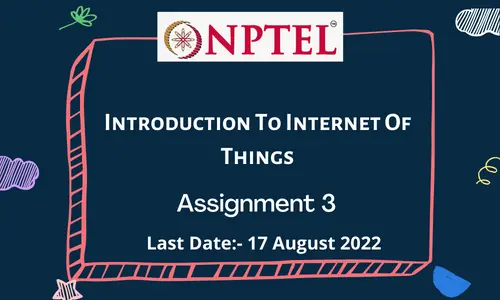NPTEL Introduction To Internet Of Things Assignment 3 Answers:- Hello students in this article we are going to share NPTEL Introduction To Internet Of Things week 3 answers. All the Answers provided below to help the students as a reference, You must submit your assignment at your own knowledge.
Below you can find NPTEL Introduction To Internet Of Things Assignment 3 Answers
| Assignment No. | Answers |
|---|---|
| Introduction To Internet Of Things Assignment 1 | Click Here |
| Introduction To Internet Of Things Assignment 2 | Click Here |
| Introduction To Internet Of Things Assignment 3 | Click Here |
| Introduction To Internet Of Things Assignment 4 | Click Here |
| Introduction To Internet Of Things Assignment 5 | Click Here |
| Introduction To Internet Of Things Assignment 6 | Click Here |
| Introduction To Internet Of Things Assignment 7 | Click Here |
| Introduction To Internet Of Things Assignment 8 | Click Here |
NPTEL Introduction To Internet Of Things Assignment 3 Answers 2022:-
1. Which of the following handles packets, paging and inquiry in Bluetooth?
a. L2CAP
b. Baseband
c. RFComm
d. Physical Radio
Answer:- b
2. Which of the following incorporates channel hopping after every packet transmission?
a. Zigbee
b. WirelessHART
c. 6LoWPAN
d. None of these
Answer:- b
3. In “X protocol, a central network controller device sets-up a network with 1 Network ID and multiple node IDs for the devices in it. The nodes with different Network IDs cannot communicate with each other. What is “X*”2
a. Z-wave
b. Zigbee
c. Bluetooth
d. ISA 100.11A
Answer:- a
4. In the context of Sensor Web, SensorML stands for
a. Sensor Modeling language
b. Sensor Machine language
c. Sensor Markup language
d. None of the above
Answer:- a
5. Which of the following protocol is best suited to provide interference-free communication while minimizing latency and ensuring quality of service?
a. WirelessHART
b. ISA100.11A
c. Both WirelessHART and ISA100.11A
d. None of these
Answer:- d
Next Week Assignment Answers
6. Which of the following solution approach is used to overcome the limitation of ineffective wakeup and sensing under rare event monitoring scenario in social sensing?
a. Duty-cycle management
b. Sleep-cycle management
c. Packet transmission management
d. Both duty-cycle and sleep-cycle management
Answer:- a
7. Which of the following technique Bluetooth master uses to avoid collisions during transmission in a Piconet?
a. Frequeney Division Multiplexing d Ou
b. Frequency Hopping Spread Spectrum
c. Time Division Multiplexing
d. Direct Sequence Spread Spectrum
Answer:- c
8. Which of the following limitation is faced by total co-operation in Wireless Ad Hoc and Sensor Networks?
a. Decreasing network throughput
b. Decreasing energy
c. Both (a) and (b)
d. No limitation exists
Answer:- c
9. Which of the following can function over a reliable packet transfer protocol?
a. L2CAP
b. Service Discovery Protocol
c. RFComm
d. Physical Radio
Answer:- b
10. In which of the following mode, NFC devices can act as both readers as well as tags?
a. Reader/writer
b. P2P
c. Emulation
d. NFC devices can’t act as both readers as well as tags
Answer:- b
11. In WSN, Information theoretic self-management (INTSEM) controls the transmission rate of a node by adjusting a node’s
a. Duty cycle
b. Lifetime
c. Sleep time
d. Can’t control the transmission rate
Answer:- c
12. Which of the following layer of ISA 100.11A supports mesh routing?
a. Netwok layer
b. Data link layer
c. Transport layer
d. MAC layer
Answer:- b
13. Which of the following is used to avoid interference-prone channels in HART?
a. Channel blacklisting
b. Channel switching
c. Channel hopping
d. Super-trames
Answer:- b
14. When the devices are not in range, messages are routed through different nodes to bypass obstructions created by household appliances or layouts. Which of the following exhibit such characteristic of avoiding radio dead-spots?
a. Bluetooth
b. 6LoWPAN
c. Z-wave
d. Zigbee
Answer:- c
15. Which of the following is TRUE in tems of power (in mW) and range (in m) of the classes of Bluetooth devices?
a. Class-1: Power=100mW, Range=100m
b. Class-2: Power=2.5 mW, Range=100m
c. Class-1: Power=2.5 mW, Range=100m
d. Class-2: Power=100 mW, Range=100m
Answer:- a
For More NPTEL Answers:- CLICK HERE
For NPTEL Artificial Intelligence Search Methods For Problem solving Assignment 1 Answers 2022
Disclaimer: We do not claim 100% surety of answers, these answers are based on our sole knowledge, and by posting these answers we are just trying to help students, so we urge do your assignment on your own.
if you have any suggestions then comment below or contact us at [email protected]
If you found this article Interesting and helpful, don’t forget to share it with your friends to get this information.


